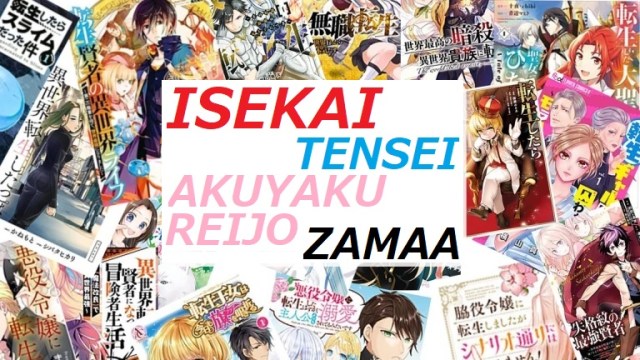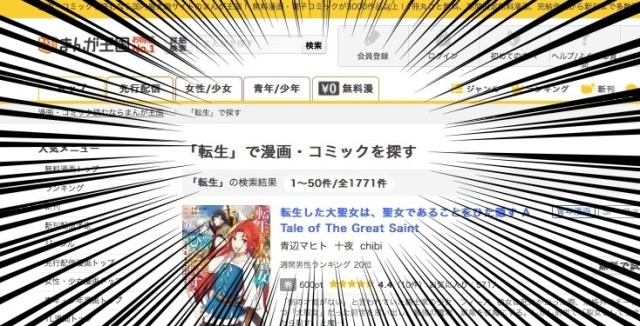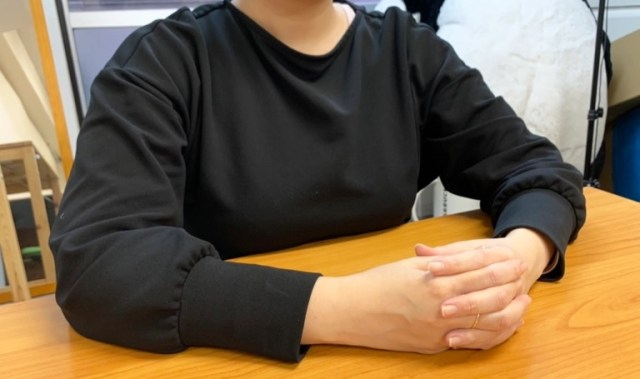
We sit down for an interview with an industry pro and learn about “zamaa-style” manga too.
Isekai, or alternate world stories, have become one of the most popular anime/manga genres, so much so that there are now a number of recognizable isekai subgenres.
For example, there’s the tensei (“reincarnation”) genre, where someone from our world doesn’t just get whisked off to another one, but dies and is reborn there as a different person, but with their real-world memories intact. There’s also the akuyaku reijo (“high-class young villainess”) category, itself a subgenre of tensei, where the main character is reborn as a powerful figure in the alternate world who’d usually be an isekai story’s antagonist.
On a whim, our Japanese-language reporter Mariko Ohanabatake decided to put “tensei” into the search function of Manga Okoku, a popular digital manga publishing site in Japan. She got back…
1,771 results, and doing the same for “akuyaku reijo” got her another 365!
But why are reincarnation and villainess stories so popular? To find out, Mariko sat down with veteran manga editor Y-san (not her real name). Y-san has been working as a manga editor at a major publisher for more than 10 years, editing series that have gone on to win awards and have anime adaptations, and here’s what she had to tell us.
Mariko: Is there a specific title that kicked off the current tensei boom?
Y-san: I think That Time I Got Reincarnated as a Slime becoming a hit was a major turning point. The series started as a web novel on the site Shosetsuka ni Narou (“Let’s Become Novelists”), and once it got popular there, it got turned into a manga. There are a lot of reincarnation stories on the site, so many that some people also call tensei stories “Narou stories.”
In the industry, we used to have a lot of time travel stories, or teni (“transfer”) stories, where someone would go to a different time or place while still retaining their original appearance and identity. But the tensei stories that are in vogue now are different in that the main character dies in our world, then they awaken in a different world as a different person, but with their real-world memories intact.
Mariko: In tensei stories, when they get to the alternate world they look different and have a completely new lifestyle, don’t they?.
Y-san: I think the reason for that is to appeal to readers who want to become a different person than they are now and redo their life. It’s a frequent characteristic of tensei stories that the main character’s real-world background and what kind of person they were before coming to the alternate world aren’t treated as being very important.
▼ Y-san
Mariko: Yeah, I’ve noticed that they don’t really go into much depth about those kinds of things.
Y-san: Usually there are just a few quick pages at the start of the first chapter about the main character’s life in our world, then they die and we get to the start of the story in the alternate world. There’s not much weight given to the kind of person they were or what kind of upbringing and experiences they had in our world. I think they just want to establish, as quickly as they can, ‘Ok, here’s this person…now he’s dead…and now he’s starting a new life.’ I’m sometimes surprised at how little need the story seems to have for readers to sympathize with the main character while they’re still in the real world.
Mariko: What about villainess reincarnation stories? I notice a lot of comics aimed at women recently where the main character was a timid person in the real world, and I can understand the desire to be reborn as a more powerful person, but why a villainess?
Y-san: Well, for a long time, the standard pattern in shojo manga has been that the main character is eventually rewarded for being purehearted and earnest. But with the advancement of social media, I think that messier, more realistic emotions and romance have become more visible, and that some people are tired of such purehearted main characters.
Mariko: I think there aren’t many people who can live their lives like a pure, earnest shojo heroine.
Y-san: But in contrast, a powerful villainess can be forcefully bold and tell off people she doesn’t like. I think that’s something people find appealing. Stories where the villainess breaks off an engagement are popular too. It might be a result of empathizing with that desire to be free of a man’s control.
Mariko: Oh, I get it now! A rich, powerful villainess can do what she wants, and doesn’t have to mince words talking with male characters. She’s basically unstoppable.
Y-san: By the way, there’s also a new genre, often aimed at male readers, with some similarities to tensei that’s called zamaa-style.
Mariko: Zamaa-style? What’s that?
Y-san: It’s from ‘zamaa miro’ [Japanese for “serves you right”]. The main character isn’t reincarnated, but instead is someone who was kicked out of a band of heroes who didn’t think he was good enough. Then the main character joins another party and finds success, while things fall apart for the party of heroes he used to be in. It’s similar to a revenge story.
Mariko: Have you ever served as the editor for a tensei manga series?
Y-san: Not a tensei one specifically, but I’ve been involved in the planning for an isekai series. But there’s something about them that…well, if I come right out and say it, I wondered if making an isekai series was a good decision for that manga artist’s future. Even if people read the series, there’s no point for the artist if that success can’t connect to their next series. Tensei series have so many similarities to each other, so it’s hard for an individual artist to develop a fanbase for themselves through one. The readers don’t generally react with, “Now I’ll check out their other works too.”
Mariko: I guess it’s true that if you can’t tell one series apart from another in the genre, you probably won’t remember the artist’s name either.
Y-san: But on the other hand, because it’s a popular genre, it’s easier for new artists to get their pitches greenlit, and there’s a big benefit to the artist on the financial end from higher sales by nature of their series being in a popular genre. The ideal is to get readers to become fans of both the series and the artist at the same time.
Mariko: Before we wrap things up, do you have any personal tensei recommendations for us manga readers?
Y-san: Of course! My Next Life as a Villainess: All Routes Lead to Doom! (art by Nami Hidaka, story by Satoru Yamaguchi) has an interesting story and an appealing cast of characters. And it’s technically a teni story, but The Screwed-up Potions Turned Out to Be Soy Sauce, So I Cooked with Them [Hazure Poshon ga Shoyu Datta no de Ryori Suru Koto ni Shimashita] (art by Risuno, story by Fuji Tomato, and character concepts by Yuichi Murakami) is another I’m really enjoying reading. It’s got a really unique concept: a housewife gets transferred to another world and realizes that its defective healing potions are actually soy sauce, so she uses them for cooking.
Mixing fantasy alchemy and Japanese cuisine? It’s something we wouldn’t have thought up on our own, and a sign that even with as many lookalike isekai series as there are, there are still some original, interesting ideas within the genre if you know where to look.
Photos © SoraNews24
● Want to hear about SoraNews24’s latest articles as soon as they’re published? Follow us on Facebook and Twitter!
[ Read in Japanese ]
Follow Casey on Twitter, where his personal isekai recommendation remains Vision of Escflowne.
[ Read in Japanese ]



 Bleakly inspiring manga shows what would really happen to average guys in anime alternate world
Bleakly inspiring manga shows what would really happen to average guys in anime alternate world Textbook for learners of Japanese with boy who can’t stop eating roses may be the weirdest ever
Textbook for learners of Japanese with boy who can’t stop eating roses may be the weirdest ever Anime’s fantasy harem genre gets a harsh dose of reality in parody manga
Anime’s fantasy harem genre gets a harsh dose of reality in parody manga Creepy shrine video has Japanese Internet wondering where it is, if it leads to alternate world
Creepy shrine video has Japanese Internet wondering where it is, if it leads to alternate world 7 new winter 2022 anime (besides Attack on Titan and Demon Slayer) our otaku reporter recommends
7 new winter 2022 anime (besides Attack on Titan and Demon Slayer) our otaku reporter recommends How to order snacks on a Shinkansen bullet train in Japan
How to order snacks on a Shinkansen bullet train in Japan Demon Slayer: Kimetsu no Yaiba gets new roller coaster attractions and food at Universal Studios Japan
Demon Slayer: Kimetsu no Yaiba gets new roller coaster attractions and food at Universal Studios Japan New samurai glasses are Japan’s latest weird must-have souvenir
New samurai glasses are Japan’s latest weird must-have souvenir Burger King Japan suddenly adds Dr. Pepper and Dr. Pepper floats to its menu nationwide
Burger King Japan suddenly adds Dr. Pepper and Dr. Pepper floats to its menu nationwide Nintendo history you can feel – Super NES, N64, and GameCube controllers become capsule toys
Nintendo history you can feel – Super NES, N64, and GameCube controllers become capsule toys High-fashion Totoro cuddle purse is like an elegant stroll in the forest【Photos】
High-fashion Totoro cuddle purse is like an elegant stroll in the forest【Photos】 Japan’s new difficult-to-drink-from beer glass protects your liver, but it’s a brutal experience
Japan’s new difficult-to-drink-from beer glass protects your liver, but it’s a brutal experience Kyoto Tower mascot termination reveals dark side behind cute Japanese characters
Kyoto Tower mascot termination reveals dark side behind cute Japanese characters New Pokémon ice cream, dessert drinks, and cool merch coming to Baskin-Robbins Japan【Pics】
New Pokémon ice cream, dessert drinks, and cool merch coming to Baskin-Robbins Japan【Pics】 To combat declining birth rate, Japan to begin offering “Breeding Visas” to foreigners
To combat declining birth rate, Japan to begin offering “Breeding Visas” to foreigners Hello, cosmetics! Clinique teams up with Hello Kitty this summer for first-time collaboration
Hello, cosmetics! Clinique teams up with Hello Kitty this summer for first-time collaboration “The most Delicious Cup Noodle in history” – Japan’s French Cup Noodle wins our heart【Taste test】
“The most Delicious Cup Noodle in history” – Japan’s French Cup Noodle wins our heart【Taste test】 Starbucks releases a cute Frappuccino and Unicorn Cake…but not in Japan
Starbucks releases a cute Frappuccino and Unicorn Cake…but not in Japan McDonald’s Japan’s Soft Twist Tower: A phantom ice cream only sold at select branches
McDonald’s Japan’s Soft Twist Tower: A phantom ice cream only sold at select branches Yabai Ramen: What makes this Japanese ramen so dangerous?
Yabai Ramen: What makes this Japanese ramen so dangerous? Finally! Nintendo Japan expands Switch 8-bit controller sales to everybody, Online member or not
Finally! Nintendo Japan expands Switch 8-bit controller sales to everybody, Online member or not Japanese government wants to build luxury resorts in all national parks for foreign tourists
Japanese government wants to build luxury resorts in all national parks for foreign tourists 10 things you should buy at 7-Eleven in Japan
10 things you should buy at 7-Eleven in Japan Studio Ghibli releases anime heroine cosplay dresses that are super comfy to wear
Studio Ghibli releases anime heroine cosplay dresses that are super comfy to wear Woman charged for driving suitcase without a license in Osaka
Woman charged for driving suitcase without a license in Osaka Studio Ghibli unveils My Neighbour Totoro miniature house model
Studio Ghibli unveils My Neighbour Totoro miniature house model Kyoto experiencing problems with foreign tourists not paying for bus fares, but not on purpose
Kyoto experiencing problems with foreign tourists not paying for bus fares, but not on purpose Fighting mild hunger with a Japanese soda that turns into jelly in the stomach【Taste test】
Fighting mild hunger with a Japanese soda that turns into jelly in the stomach【Taste test】 Studio Ghibli’s Howl’s Moving Castle tapestry unveiled in Japan for first time
Studio Ghibli’s Howl’s Moving Castle tapestry unveiled in Japan for first time McDonald’s new Happy Meals offer up cute and practical Sanrio lifestyle goods
McDonald’s new Happy Meals offer up cute and practical Sanrio lifestyle goods Sales of Japan’s most convenient train ticket/shopping payment cards suspended indefinitely
Sales of Japan’s most convenient train ticket/shopping payment cards suspended indefinitely Sold-out Studio Ghibli desktop humidifiers are back so Totoro can help you through the dry season
Sold-out Studio Ghibli desktop humidifiers are back so Totoro can help you through the dry season Japanese government to make first change to romanization spelling rules since the 1950s
Japanese government to make first change to romanization spelling rules since the 1950s Foreigner’s request for help in Tokyo makes us sad for the state of society
Foreigner’s request for help in Tokyo makes us sad for the state of society Ghibli founders Toshio Suzuki and Hayao Miyazaki contribute to Japanese whisky Totoro label design
Ghibli founders Toshio Suzuki and Hayao Miyazaki contribute to Japanese whisky Totoro label design Doraemon found buried at sea as scene from 1993 anime becomes real life【Photos】
Doraemon found buried at sea as scene from 1993 anime becomes real life【Photos】 Tokyo’s most famous Starbucks is closed
Tokyo’s most famous Starbucks is closed Princesses, fruits, and blacksmiths: Study reveals the 30 most unusual family names in Japan
Princesses, fruits, and blacksmiths: Study reveals the 30 most unusual family names in Japan Death Note manga’s first new collected volume in 14 years announced
Death Note manga’s first new collected volume in 14 years announced Do women who love manga have a harder time finding real-life romance?
Do women who love manga have a harder time finding real-life romance? “What the hell are you doing to my woman?” attacker asks man feeding stray cat in Tokyo park
“What the hell are you doing to my woman?” attacker asks man feeding stray cat in Tokyo park Hugh Jackman stars, sings J-pop cover, and speaks Japanese in ads for Toyota【Videos】
Hugh Jackman stars, sings J-pop cover, and speaks Japanese in ads for Toyota【Videos】 Do Japanese people think all those anime characters REALLY have blue, pink, and green hair?
Do Japanese people think all those anime characters REALLY have blue, pink, and green hair? Shop in Tokyo’s Chinatown has TWENTY kinds of delicious homemade steamed buns
Shop in Tokyo’s Chinatown has TWENTY kinds of delicious homemade steamed buns What would anime hit Your Name look like without its biggest storytelling cheat? Manga shows us
What would anime hit Your Name look like without its biggest storytelling cheat? Manga shows us Creator of Japanese manga Bleach searches for fan to thank him for his dying message
Creator of Japanese manga Bleach searches for fan to thank him for his dying message Attack on Titan sketch wows Twitter users and other manga artists alike
Attack on Titan sketch wows Twitter users and other manga artists alike Popular virtual YouTubers Love-chan and Aipii get an adorable makeover
Popular virtual YouTubers Love-chan and Aipii get an adorable makeover Naomi Osaka becomes shojo manga star for new series set in outer space
Naomi Osaka becomes shojo manga star for new series set in outer space Oh, it turns out manga creator Rumiko Takahashi’s schedule is EVEN CRAZIER than we thought!
Oh, it turns out manga creator Rumiko Takahashi’s schedule is EVEN CRAZIER than we thought! Is it time for manga and anime to start introducing the coronavirus outbreak to their settings?
Is it time for manga and anime to start introducing the coronavirus outbreak to their settings? How often do Japanese high school kids watch anime, and do boys and girls watch the same series?
How often do Japanese high school kids watch anime, and do boys and girls watch the same series?
Leave a Reply